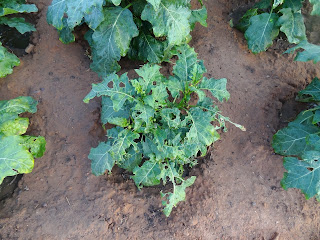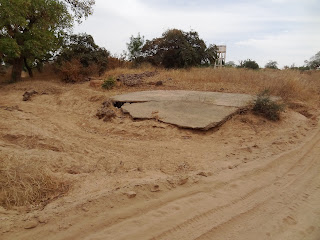Dry Season Doldrums
Dry season continues in Senegal. In a little over a month, the first rains
will come. Unlike in Guinea, where the
rains start in May, the rains in central Senegal don’t start until July. It’s barely enough time to grow field crops
of millet, corn, peanuts, and sesame.
The demonstration garden that I have devoted most of my time
to is currently “resting.” My
counterpart has been busy building a new house.
You see, the main road that passes through his village is being expanded
and improved. His current family
compound is slated for demolition to make room for the improved route. So my counterpart has been laboring away
trying to get his house built so he can return to building his garden paradise.
 |
| My counterpart and his new house... in progress. |
In the meantime, I continue to gather compost materials for
the rainy season. Chicken manure, goat
and sheep manure, bird feathers, fish waste, charcoal, peanut shells and more
are being hoarded underneath the only tree in the garden.
I know, I never thought it would happen to me.
Hoarding organic fertilizer!
Okay… garbage!
(Actually, it’s not really garbage; it is food for soil
microbes.)
What have I gotten myself into?
Please, somebody give me a plant!
Initially, I thought that my collection of materials for a
“super compost” would be rather benign.
But because my counterpart has been sidelined a bit longer than both of
us expected, my stash has become the home for a nice family of rats!
Yikes!
But I am old enough to know that
When life serves you rats, you make ratatouille.
For the children.
Yes,
they,
the children,
eat rats….
When they can catch them!
And I have caught a few with my nifty invention.
Though there are no chickens in the garden to accidently eat
rat poison (see my previous post about that experience in Guinea), using
commercial rat poison is not an option for two reasons: my counterpart is
committed to organic methods, and more importantly, all his money is going into
building his new house. As I am serving
as a Peace Corp volunteer, I have declined to buy commercial (and toxic) rat
poison as this would not only set a bad example (When the going gets tough,
it’s okay to compromise) and it would not be sustainable (I would soon have all
the villagers coming to me to buy them poison as well.)
So not taking a short cut has forced me to find a more
sustainable way to eliminate a rodent infestation.
(I did willingly come here to solve problems.)
The solution which I have directed my efforts is one in
which any African living in the bush can duplicate: a clay pot (or plastic jug)
buried in the ground, and nearly filled with water. With the right incentive, rats either jump or
fall into the drink and bye bye rat.
Peanut butter placed on a conveniently angled slippery slope (plastic)
seems to do the trick okay, but I am still experimenting with the most
effective “assist” with the getting the critters into the pot. (On occasion, the rats are able to enjoy a
free lunch without going for a swim.)
 |
| An early version of my rat trap. |
In the meantime, I need to find me a plant… to make use of
my organic fertilizer.
I promise to keep all my readers updated.
On both the number of rats we catch…
And
What the village children have been eating for dinner!








